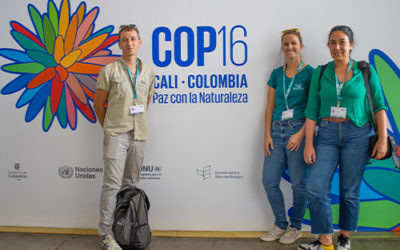On September 23rd, 2015, Solicaz took part in the Legumes event at Matiti Agricultural High School, which brought together about 40 actors from the agricultural world.
The aim was to present the advantages of planting legumes in pastures, or on crop or fruit-growing plots to public farmers in French Guiana.
Rainer Schultze Kraft, an expert from CIAT (International Centre for Tropical Agriculture) who worked on a collection of tropical forage resources adapted to acid soils, presented a case study of successful agricultural association experiments in breeding / farming systems at the international level.
There at the Matiti Agricultural School, he highlighted the various benefits of using legumes, which improve soil fertility by providing organic matter, a structure for better soil conservation, erosion management and weed control. Legumes make it possible to produce forage of high nutritional value and high regeneration potential from a seed storage in the soil. They can also be used as an essential complement to traditional forage grasses, whose nutritional value decrease with age.
Rainer Schultze Kraft concluded his presentation by emphasizing that legumes are an important ally capable of increasing the production of meat, crops and/or trees in farming and other systems.
The guests were then able to see the fodder platform and the active fallow of the school before discovering the different experiments carried out by IKARE and SOLICAZ at the local level.

William Montaigne, Doctor of Ecology at Solicaz presented the results obtained on experiments whose aim was to improve the management of soil fertility in farming systems in French Guiana. For this purpose, an active fallow was set up with 3 legumes: Mucuna pruriens, Crotalaria ochroleuca and Cajanus cajan. After six months, high biomass production and improved soil fertility were observed as the control had been covered with weeds. The second experiment aimed to observe the impact of nitrogen fertilization on crops with a combination of Brachiaria humidicola and Desmodium ovalifolium. Two months after implantation, soil fertilization was already very promising and there was an improvement in the forage’s nutritional value.
Legumes allow for the sparing use of chemical fertilizers via their nitrogen fertilization capacities, which improves the intake and nutritious value of forage.

Géraldine PAUL, agricultural engineer at SOLICAZ has developed the subject of agroforestry by presenting legumes of Inga type, “sweet pea.” As part of an experiment, several species were planted on a soil that was deeply degraded. In two years, a biodiversity of flora and fauna (underground and aerial) reappeared.
Review of the day: Farmers benefit from including a legume species in their forage or crop systems. In addition to improving the structure and fertility of the soil, they save money and increase the yield of the meat, crops and biomass produced.


